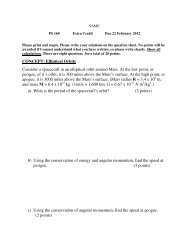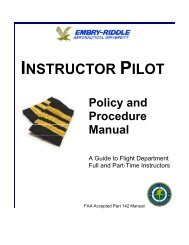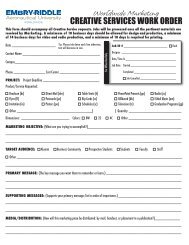checklist - ERAU ETA - Embry-Riddle Aeronautical University
checklist - ERAU ETA - Embry-Riddle Aeronautical University
checklist - ERAU ETA - Embry-Riddle Aeronautical University
Create successful ePaper yourself
Turn your PDF publications into a flip-book with our unique Google optimized e-Paper software.
52 PA-28R-201 SOP<br />
5. STARTER ENGAGE<br />
With the prop area remaining clear, no response from the callout, the key<br />
installed in the ignition switch, the throttle positioned appropriately, and the<br />
Mixture Control held, turn the key in the spring-loaded ignition switch<br />
clockwise to the “Start” position to ENGAGE the STARTER.<br />
6. MIXTURE CONTROL FULL FORWARD (Full Rich)<br />
Once the engine starts, smoothly move the MIXTURE CONTROL to the<br />
FULL FORWARD (Full Rich) position while simultaneously releasing the<br />
key to allow it to return to the “Both” position to cease starter operation, and<br />
to allow the engine to operate on both magnetos.<br />
CAUTION<br />
To prevent starter damage, limit starter cranking to 10 seconds,<br />
followed by a 20 second rest (“cool down”) period between<br />
engine cranking attempts. Maximum of six (6) start periods<br />
allowed. If engine start is not achieved on the sixth attempt,<br />
contact Fleet Maintenance. After the sixth attempt, the starter<br />
must be allowed to cool for thirty (30) minutes before<br />
attempting to start the engine again.<br />
7. THROTTLE 1000 RPM<br />
Adjust the THROTTLE to set 1000 RPM immediately to avoid high power<br />
settings without oil being circulated in the engine.<br />
8. MIXTURE LEAN<br />
LEAN the MIXTURE by slowly bringing the Mixture Control aft to the stop.<br />
9. OIL PRESSURE CHECK<br />
CHECK the OIL PRESSURE gauge to observe an increase in pressure<br />
normally within 30 seconds after engine start. Allow no more than 45<br />
seconds when engine starting in cold ambient air temperatures.<br />
CAUTION<br />
If no rise in oil pressure is observed, immediately shut down<br />
the engine to avoid damage.<br />
Revised 07-01-2012 © <strong>Embry</strong>-<strong>Riddle</strong> <strong>Aeronautical</strong> <strong>University</strong> Rev 06

















